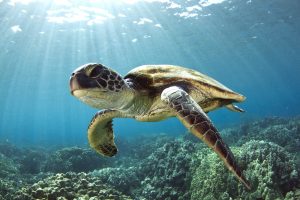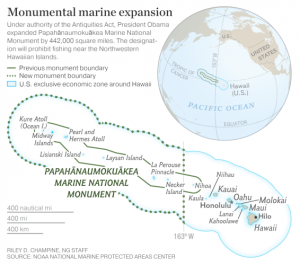
This morning I saw humpback whales breaching, a monk seal basking on the rocks, spinner dolphins on the horizon and swam with sea turtles. This is no surprise considering I am lucky enough to spend reading week on Kauai, one of the Hawaiian Islands.
Hawaii is the endangered species capital of the world and a sanctuary for many plants and animals. As of July 2016, Hawaii was home 434 species—421 endangered species and 13 threatened species—listed under the federal Endangered Species Act (ESA). With the threat of global warming, many places in the world are experiencing dwindling biodiversity. Hawaii could easily be unrecognizable in the near future, but thankfully in the last few days of his presidency, President Obama quadrupled the size of Papahānaumokuākea, a national marine monument off northwestern Hawaii.

Biodiversity is an important part of sustainability and a complex problem I am learning more about all the time. Although I don’t fully understand the implications of dying species, I do understand that when species become endangered or extinct (from the negative impact of humans) there can be wide reaching and incalculable environmental change.
Having such a large protected area and decreasing the amount of ocean fishing will not only help protect the biodiversity in the water but also help the rest of the world combat climate change by creating “blue parks.” According to Sylvia Earle, a National Geographic explorer-in-residence, biodiversity holds the planet steady and is vitally important to our life support system.
The Trump Administrations threat to “modernize” the Endangered Species Act puts biodiversity in dangerous waters and makes me thankful for previously established conservation areas like Papahānaumokuākea.
BronteGoldberger
April 9, 2017 — 5:33 pm
Sweet article. I love how you zoned in one specific issue. It is so easy to get carried away in the gargantuan problems our earth faces. I remember reading a National Geographic article way back in the day about how at the current rate of global warming, Hawaii could become fully submerged in the next hundred years. It is insane to think that such a beautiful and ecologically diverse area of the world must fight so hard to keep its species alive. This area of conservation will indeed help, but I wonder how far the effects will actually be. Ocean life is less studied than the moon or mars. There is so much we don’t know, but what we do know for certain is that there are no lines that separate the oceans. Meaning, the seas are all connected in some way, shape, or form. I fear that even with this area being protected, it might not help if another area close to it is not.